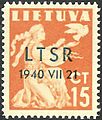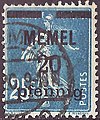
An overprint is an additional layer of text or graphics added to the face of a postage or revenue stamp, postal stationery, banknote or ticket after it has been printed. Post offices most often use overprints for internal administrative purposes such as accounting but they are also employed in public mail. Well-recognized varieties include commemorative overprints which are produced for their public appeal and command significant interest in the field of philately.

The Reichskommissariat Ostland was established by Nazi Germany in 1941 during World War II. It became the civilian occupation regime in Lithuania, Latvia, Estonia, and the western part of Byelorussian SSR. German planning documents initially referred to an equivalent Reichskommissariat Baltenland. The political organization for this territory – after an initial period of military administration before its establishment – involved a German civilian administration, nominally under the authority of the Reich Ministry for the Occupied Eastern Territories led by Nazi ideologist Alfred Rosenberg, but actually controlled by the Nazi official Hinrich Lohse, its appointed Reichskommissar.
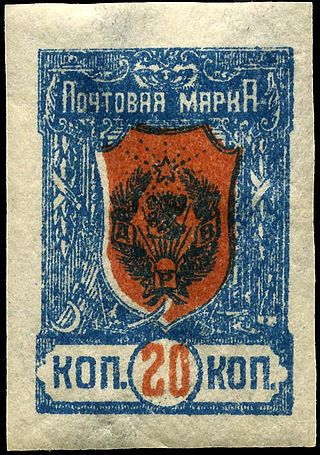
The Far Eastern Republic, sometimes called the Chita Republic, existed from April 1920 to November 1922 in the easternmost part of Siberia. It was formed from the Amur, Transbaikal, Kamchatka, Sakhalin, and Primorye regions. In theory, it extended from Lake Baikal to Vladivostok but, in May 1921, the Priamur and Maritime Provinces seceded. Although nominally independent, it was largely controlled by the RSFSR and its main purpose was to be a democratic buffer state between the RSFSR and the territories occupied by Japan during the Russian Civil War to avoid war with Japan. Initially, its capital was Verkhneudinsk, but from October 1920 it was Chita. On 15 November 1922, after the war ended and the Japanese withdrew from Vladivostok, the Far Eastern Republic was annexed by Soviet Russia.

The June Uprising was a brief period of the history of Lithuania in late June 1941 between the first Soviet and the Nazi occupations.
Each "article" in this category is in fact a collection of entries about several stamp issuers, presented in alphabetical order. The entries themselves are formulated on the micro model and so provide summary information about all known issuers.
Each "article" in this category is in fact a collection of entries about several stamp issuers, presented in alphabetical order. The entries themselves are formulated on the micro model and so provide summary information about all known issuers.
Each "article" in this category is a collection of entries about several stamp issuers, presented in alphabetical order. The entries are formulated on the micro model and so provide summary information about all known issuers.

Karelia has appeared in philately several times; first as a breakaway republic from Soviet Russia in 1922, later when Eastern Karelia was occupied by Finland during the Continuation War of 1941 to 1944, and in the post-Soviet period when provisional stamps and cinderellas were issued. Additionally, there were Zemstvo stamps used in the early 20th century on the territory of the contemporary Republic of Karelia.
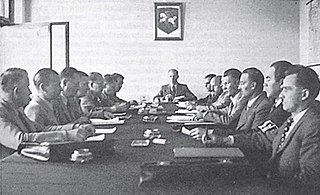
The Provisional Government of Lithuania was an attempted provisional government to form an independent Lithuanian state in the last days of the first Soviet occupation and the first weeks of the German occupation of Lithuania during World War II in 1941.

After the German invasion of the Soviet Union, the Baltic states were under military occupation by Nazi Germany from 1941 to 1944. Initially, many Estonians, Latvians, and Lithuanians considered the Germans liberators from the Soviet Union.

This is a survey of the postage stamps and postal history of Serbia.

The Holocaust in Lithuania resulted in the near total eradication of Lithuanian (Litvaks) and Polish Jews[a] in Generalbezirk Litauen of the Reichskommissariat Ostland in the Nazi-controlled Lithuania. Of approximately 208,000–210,000 Jews at the time of the Nazi invasion, an estimated 190,000 to 195,000 were killed before the end of World War II, most of them between June and December 1941. More than 95% of Lithuania's Jewish population was murdered over the three-year German occupation, a more complete destruction than befell any other country in the Holocaust. Historians attribute this to the massive collaboration in the genocide by the non-Jewish local paramilitaries, though the reasons for this collaboration are still debated. The Holocaust resulted in the largest loss of life in so short a period of time in the history of Lithuania.
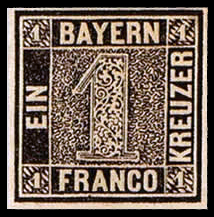
This is a survey of the postage stamps and postal history of Germany and philatelically related areas. The main modern providers of service were the Reichspost (1871–1945), the Deutsche Post under Allied control (1945–1949), the Deutsche Post of the GDR (1949–1990), the Deutsche Bundespost (1949–1995), along with the Deutsche Bundespost Berlin (1949–1990), and are now the Deutsche Post AG.

Germania stamps are definitive stamps that were issued by the German Empire and the Weimar Republic between 1900 and 1922, depicting Germania. They represent the longest running series in German philately and are in their many variations and derivations an essential part of German philatelic collections.

The military occupation of Lithuania by Nazi Germany lasted from the German invasion of the Soviet Union on June 22, 1941, to the end of the Battle of Memel on January 28, 1945. At first the Germans were welcomed as liberators from the repressive Soviet regime which had occupied Lithuania. In hopes of re-establishing independence or regaining some autonomy, Lithuanians had organized a Provisional Government. It lasted six weeks.

Postal history in the territory that now constitutes Latvia began during the 13th century, when the Archbishopric of Riga was included to the area of postal operations of the Monastic state of the Teutonic Knights and the Hanseatic League. In 1580 the Hanseatic League issued their first known regulations on courier work and payroll, regulations that also were active in the territory that now constitutes Latvia.

This is a survey of the postage stamps and postal history of Ukraine.
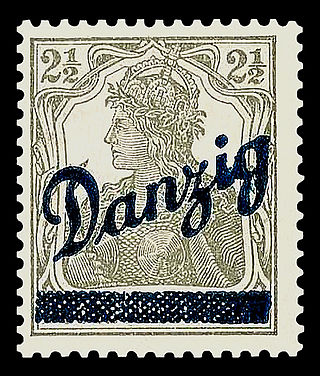
This is an overview of the postage stamps and postal history of the Free City of Danzig .






